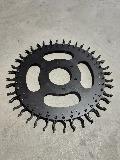Search Results (Searched for: stepper spindle)
- konrad
- konrad
31 Mar 2025 14:54
config all good on mesa 7i96s? was created by konrad
config all good on mesa 7i96s?
Category: General LinuxCNC Questions
- Routerworks
- Routerworks
28 Mar 2025 14:23
Replied by Routerworks on topic Need help setting up XYYZA for stepper motors
Need help setting up XYYZA for stepper motors
Category: General LinuxCNC Questions
- PCW

27 Mar 2025 18:12 - 27 Mar 2025 18:21
Replied by PCW on topic Need help setting up XYYZA for stepper motors
Need help setting up XYYZA for stepper motors
Category: General LinuxCNC Questions
- aharner
- aharner
24 Mar 2025 20:43
Connecting Mesa 7i76 to Sprint 1200 DC Controller was created by aharner
Connecting Mesa 7i76 to Sprint 1200 DC Controller
Category: General LinuxCNC Questions
- gm001
- gm001
21 Mar 2025 05:21
- richcolvin

20 Mar 2025 16:54
C Axis as Second Spindle was created by richcolvin
C Axis as Second Spindle
Category: General LinuxCNC Questions
- unknown
- unknown
19 Mar 2025 12:24
Replied by unknown on topic EtherCAT Closed-Loop Drive Options for Lathe
EtherCAT Closed-Loop Drive Options for Lathe
Category: EtherCAT
- scda

17 Mar 2025 14:29
Replied by scda on topic caxis.comp with stepper motor / gear connection to spindle
caxis.comp with stepper motor / gear connection to spindle
Category: HAL
- spumco
- spumco
16 Mar 2025 23:54
Replied by spumco on topic caxis.comp with stepper motor / gear connection to spindle
caxis.comp with stepper motor / gear connection to spindle
Category: HAL
- scda

16 Mar 2025 21:08
Replied by scda on topic caxis.comp with stepper motor / gear connection to spindle
caxis.comp with stepper motor / gear connection to spindle
Category: HAL
- spumco
- spumco
16 Mar 2025 18:30
Replied by spumco on topic caxis.comp with stepper motor / gear connection to spindle
caxis.comp with stepper motor / gear connection to spindle
Category: HAL
- scda

16 Mar 2025 15:04 - 16 Mar 2025 15:09
caxis.comp with stepper motor / gear connection to spindle was created by scda
caxis.comp with stepper motor / gear connection to spindle
Category: HAL
- PCW

13 Mar 2025 15:50 - 13 Mar 2025 16:45
Replied by PCW on topic Steppers motor start moving without any commads being given
Steppers motor start moving without any commads being given
Category: General LinuxCNC Questions
- jtrantow
- jtrantow
08 Mar 2025 15:08
Replied by jtrantow on topic Lathe spindle index only?
Lathe spindle index only?
Category: Basic Configuration
- Aciera

03 Mar 2025 09:05 - 03 Mar 2025 09:14
Time to create page: 0.752 seconds
